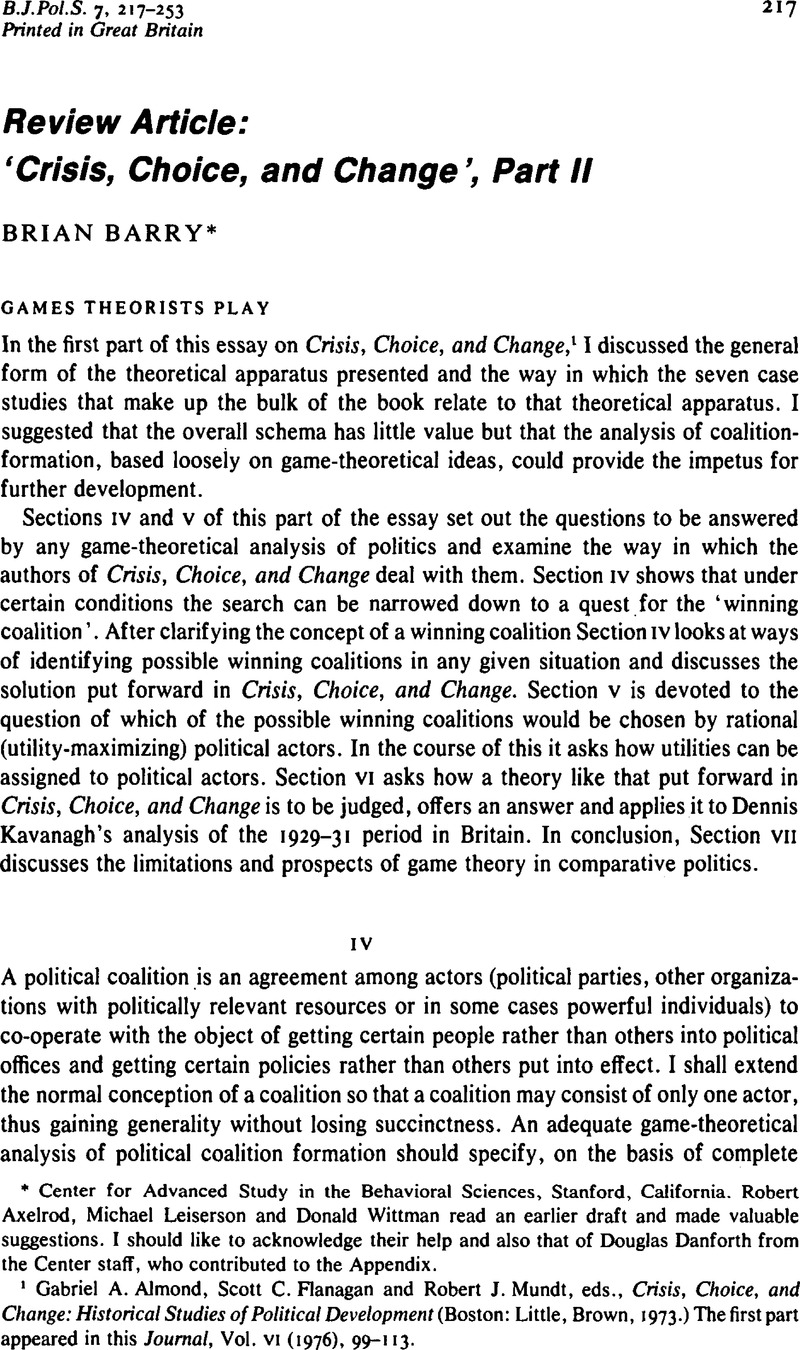No CrossRef data available.
Article contents
‘Crisis, Choice, and Change’, Part II
Published online by Cambridge University Press: 27 January 2009
Abstract

Information
- Type
- Review Article
- Information
- Copyright
- Copyright © Cambridge University Press 1977
References
1 Almond, Gabriel A., Flanagan, Scott C. and Mundt, Robert J., eds., Crisis, Choice, and Change: Historical Studies of Political Development (Boston: Little, Brown, 1973.)Google Scholar The first part appeared in this Journal, Vol. VI (1976), 99–113.Google Scholar
2 This is nowhere stated explicitly in the book but it may be found in an article by Flanagan which mostly follows his chapter word for word but is occasionally, as here, more specific. See Flanagan, Scott, ‘Theory and Method in the Study of Coalition Formation’, Journal of Comparative Administration, v (1973), 267–314, p. 293.CrossRefGoogle Scholar
3 Flanagan, , ‘Theory and Method’, p. 293.Google Scholar
4 The reader may think that it is a funny sort of winning that you like less than losing, and it is true that as we move away from zero-sum games with transferable utility the concept of winning becomes less appropriate. In the present instance, it would be better to say ‘coalitions that could impose office-holders and policies if their members chose to do so’.
5 To complete the story, if C dislikes the prospect of a BC coalition more than it dislikes the outcome where no coalition is formed, B's threat against C to refuse to join an AB coalition becomes valueless. Formally, the best way to handle this seems to be to say that ‘no coalition’ dominates BC, while ‘no coalition’ is in turn dominated by AB. Therefore, only AB is left in, which is the correct answer in this case.
6 Let me give two examples of over-inclusion. In Table III. 3 (Britain, 1826, p. 135), the coalition that actually formed was one of Whigs, Tory centre, Crown and Tory ultras. This coalition (No. 1) is included in the ‘preferred set’ (i.e. the set of coalitions one of which is predicted by the theory to form), thus notching up a success for the theory. But the Whigs are shown as rating such a coalition at a utility of – I, and they have three alternative coalitions available above the ‘line of effectiveness’ that yield positive utility scores and one other that yields zero. The coalition should therefore be excluded from the ‘preferred set’ under criterion (1). In Table IV. 9 (Britain, August 1931, p. 203) the actual outcome is a Conservative-Liberal-MacDonald coalition (No. 2) and this is included in the ‘preferred set’. But under criterion (3) it should be eliminated because it is dominated by No. 3, a Conservative-Liberal coalition: the Liberals are shown as preferring it by 2 units to 1, and the Conservatives by 6 to 4. The theory should therefore be counted as not having included the actual outcome in the ‘preferred set’ here.
7 I think that the second criterion for dismissing possible winning coalitions from the ‘preferred set’ may yield some examples. It may be recalled that this criterion calls for the elimination of any coalition that does not provide the highest utility score for at least one member, on the (spurious) ground that any coalition failing to meet this condition is dominated. But there is the proviso that this criterion does not apply if the coalition has a higher ruling potential (however little more) and the utility score does not fall short by more than one unit from the highest. It is quite remarkable how often a plausible coalition that would be eliminated without the proviso managed to stay in on the strength of 0·1 or 0·2 more ‘ruling potential’.
8 Luce, R. Duncan and Raiffa, Howard, Games and Decisions (New York: Wiley, 1957), p. 83.Google Scholar
9 It is, of course, an argument advanced in Britain against the plurality electoral system that it enables a party to obtain enough parliamentary resources to constitute a winning coalition without its being able to gain enough co-operation in the country to govern effectively. But the problem seems to lie less in the relation between popular votes and parliamentary seats than in the relation between popular votes and organized interests: what guarantee is there that a government backed by parties corresponding to a majority of the popular vote would be able to govern effectively? The perennial suggestions that the House of Lords should be reconstituted on a ‘functional’ basis are more directly related to the idea that constitutionally allocated power should be brought into line with extra-constitutional power.
10 It should be noted that the objection of circularity would not lie against the notion that the government in office before an election has an opportunity to improve its chances of winning the next election, whether by instructing officials what results to declare, hampering the opposition, controlling broadcasting and newspapers or more subtly by manipulating policy so as to achieve last-minute popularity.
11 Mill, J. S., A System of Logic (London: Longmans, 1961), p. 6.Google Scholar

